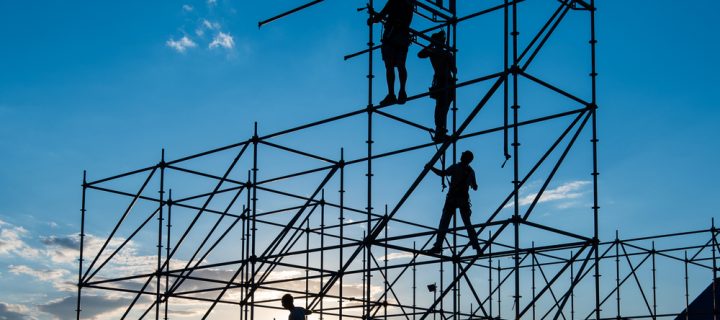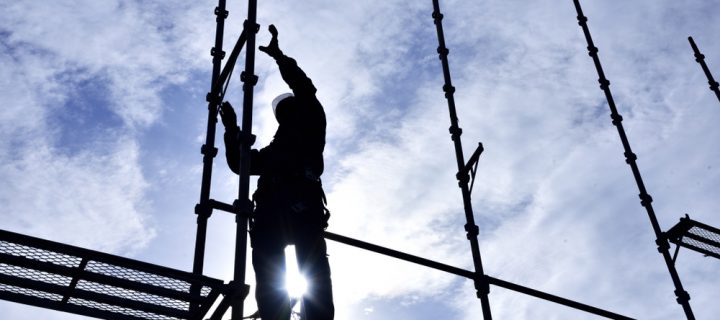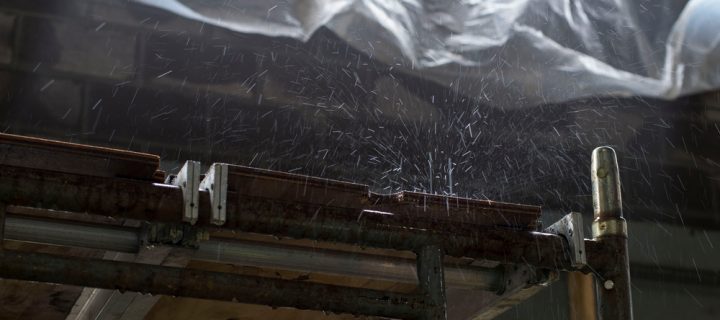With such a long and illustrious history, the art of scaffolding has taken many interesting forms and been used for a variety of different purposes. With so much history, it seems inevitable that there will be many interesting snippets of information. While some facts might seem quite trivial, others provide genuinely interesting insight into the industry we all know and love. Whether it involves scaffold erecting, safety decking or scaffold dismantling, there are many interesting facts to learn. Some may even surprise you. So, let’s look at some of the interesting facts about scaffolding. Scaffolding Dates Back To 5th Century BC We have rather recently covered the intriguing history of scaffolding in one of our previous blogs. However, the incredible history of scaffolding can never actually be dealt justice with such a brief summary. While the exact invention of scaffolding is yet to be exactly pinpointed, many historians cite ancient Greece in or around the 5th Century BC as being the first recorded cases of scaffolding being used. It must be noted however, that the first real steps towards scaffolding were taken all the way back in ancient China. This was when bits of bamboo were tied together to create something resembling a scaffolding structure. Bamboo Scaffolding Was Used On The Great Wall of China Speaking of China, bamboo scaffolding was used to help the great wall of China. We have recently touched on the fact that in China; bamboo is the preferred material for scaffolding. But the fact that the scaffolding in question was used to build one of the seven wonders of the world is beyond impressive. Michelangelo Has The Most Impressive Scaffolding Portfolio Throughout its historic use, scaffolding has had many designers take advantage of it’s multiple purposes. Many of these designers or constructionists have gone on to use scaffolding to build some of the most impressive buildings and structures known to man. All of this being said, there is probably one designer who has the best portfolio in terms of scaffold erecting. This is, of course, Michelangelo. For many historians, Michelangelo is considered the best scaffolder of all time. He did use scaffolding to help build the Sistine Chapel amongst many other world renowned landmarks. The...
Read Moreabout Generally Interesting Facts About ScaffoldingWhilst summers in Derbyshire do not typically reach extremely high temperatures; the summer season can create unique and special problems. This summer is forecast to be potentially the hottest on record. As such, there be certain unique problems. This is even more apparent when you consider scaffolding in Derbyshire. Typically, summers in Derby can reach temperatures of 29 degrees Celsius. However, it must be noted that the average temperature for the summer period is only about 21 degrees. It is not just the high temperatures which can cause problems in the summer though. There can also be a significant amount of rainfall. While Derby in the summer might only see around 8 days of rainfall a month, when the rain does come down, it can seem quite significant and problematic. Now that summer has officially arrived, we thought why not take a look at some of the ways you can work on and/or erect scaffolding in Derby this summer. Eye Protection When working on any construction project, eye protection should be handled with a great deal of care. This is all the more relevant in the summer however. We might hope that through the majority of the summer, the sun will be shining. While the sun shining might help to improve your mood, it can actually produce a visual impairment when working. If the sun is shining directly into a worker’s eyes it will make it much harder for them to see and subsequently will make them feel uncomfortable. To combat this, you might want to ensure that your workers have eye protection and/or shade to avoid the glare of the sun. More Frequent Breaks During Extreme Temperatures As previously alluded to, sometimes in Derbyshire, temperatures can reach abnormal heights. If this rare occurrence is to happen, then you might want to consider taking more frequent breaks. Performing physical activities at the warmest point in the day can cause the body to overheat. To combat this, try to take more water breaks during the warmest parts of the day and also find shade where possible. Provide Shade Where Possible As previously alluded to, you will want to provide shade to workers where possible. This helps protect against heat exhaustion and...
Read Moreabout Scaffolding In Derbyshire This SummerScaffold erecting in Derbyshire is one, if not the most, important and all encompassing services we supply. Safely and effectively putting scaffolding up might seem like a relatively simple and mundane task. However, enacting the process requires sufficient training and able personnel. The process can sometimes seem quite convoluted to the uninitiated. On the whole, the process is a high risk activity. While it is highly not recommended to try and assemble scaffolding on your own without the relevant tools and equipment; at Network Scaffolding we want our customers to have a better understanding of our beloved industry. As such, we thought why not detail a general step by step guide on how to erect scaffolding. We have recently touched on some of the most commonly used jargon in the scaffolding industry and we have touched on the various components of scaffolding. It might be worth revisiting these blogs to garner a better understanding of what we will be talking about. Whilst there is no one size all in regard to scaffold erecting, there are definitely some do’s and don’ts and that is why we thought we should provide a more general guide. A Secure and Safe Foundation When it comes to erecting scaffolding; first thing is first. To build a secure and sturdy structure, you will require a sufficient foundation and solid working platform. Depending on the location and type of scaffolding, you have to select one of either base plates or mud sills to attach the structure to. When selecting the foundation, you will be required to ensure the location is close to the establishment you are working on; whether that be a commercial building or a domestic property. You should then ensure the foundation is level. If the flooring is uneven, you might need to dig a hole to put the scaffolding in. This ensures the structure remains steady. Does The Structure Need to Move? When assembling the scaffolding structure, you will need to evaluate if the structure needs to be moved at any point of the project. When working on domestic properties in particular, the structure might be required to move and therefore; you might need to attach casters to the bottom to enable free...
Read Moreabout Step By Step Guide To Scaffold ErectingWhen it comes to scaffolding in Derbyshire, many of the types displayed are usually traditional forms of scaffolding. It is not uncommon to see different types of access scaffolding. However, one type of scaffolding that can be found in Derby but which is not overly common is cantilever scaffolding. Exactly what cantilever scaffolding is can confuse some people who aren’t involved in the industry. So, we decided to focus on what cantilever scaffolding is and how it can benefit you and/or your business. What Is Cantilever Scaffolding Cantilever is an excellent access solution for both commercial and domestic scenarios. This unique type of scaffolding is becoming ever the more popular; this is due to the fact that it is very easy to erect and dismantle. Accompanying this, is the fact that the scaffolding structure helps expert scaffolders to access hard to reach places as well as offering unrivalled levels of protection and support. As mentioned above, due to the unique form of cantilever scaffolding; it enables workmen access to typically hard to reach places. The cantilever style conveniently eliminates the requirement for poles and frames in front of scaffolding structure. This unique form of scaffolding is often used when there is an obstacle or narrow pathway obstructing access to an area. An often cited big advantage of cantilever scaffolding is the fact that it is extremely cost effective when it comes to erecting and dismantling scaffolding in areas that do not typically allow for such freedom. The 3 in 1 Rule Much like other forms of scaffolding; health and safety should always be at the forefront, regardless of the scaffolding type. While the cantilever scaffolding type is safe, there are still many precautions you can take to ensure everything remains as safe as possible. As such, when it comes to working on cantilever scaffolding you might want to consider the 3 in 1 rule. The 3 in 1 rule details that the total working height of the scaffolding tower should be 3 times the distance of the narrowest side of the base. If these requirements are not met; the tower should be secured by guide wires to ensure the structure remains sturdy and secure at all times. These guidelines...
Read Moreabout An Informative Guide To Cantilever ScaffoldingAs we have stated in many of our previous blogs, safety decking is an industry leading fall prevention system. The system is becoming ever the more popular with scaffolding companies. This is largely due to its incredible health and safety benefits. While the advantages of safety decking far outweigh the negatives; such as the incredibly easy installation process and the previously mentioned fall protection technology, there are some instances where this industry leading safety platform technology can be a slight hindrance or minor hiccup. No matter the month in the UK, we can unfortunately see quite a lot of rainfall. This inevitably leads to wet and slippery decking. With the majority of safety decking being plastic, this creates even more of a problem. Although it might go without saying, we thought it best to state it here, plastic when wet, can be very slippery. As you might have already guessed, having slippery flooring can lead to potentially catastrophic incidents. Luckily, the safety decking system supplied by Network Scaffolding is non-slip and extremely versatile. Although our product is non-slip, there are still certain steps you should take. This is to ensure the integrity of the structure and quality remain as consistent as ever. As such, let’s look at what to do with wet safety decking or any other scaffold decking for that matter. Dry It Safely And Effectively It might go without saying, but if your decking is wet, you will want to dry it as soon as possible. You should do so safely and effectively. Although our technology is non-slip, keeping your decking as dry as possible is always a benefit. There are many ways you can dry your decking. These can include simply using paper towels and/or other clothes to quickly dry them. Or, even using a dehumidifier if you happen to have the time and facilities to do so. Remove Leaves Depending where your scaffolding has been erected, you might garner a range of leaves on your structure. When wet, leaves produce another potential slip hazard. Because of this, you will do well to promptly and effectively remove the leaves as soon as they fall onto your structure. The sentiment is echoed for any other debris. Aside...
Read Moreabout What To Do With Wet Safety DeckingAt Network Scaffolding Services, we have many years of experience in the scaffolding in Derbyshire sector. As such, our intricate and thorough knowledge has been showcased multiple times on our blog. In one of our previous blogs; we actually detailed some of the potentially confusing jargon that is often used amongst scaffolders. Or, even more recently, we detailed some of the most used components and equipment in scaffolding. While many of us would prefer not to acknowledge it, the scaffolding business can heavily revolve around official documentation. One of the most famous forms of documentation or paperwork which should be considered before any work is commenced on a scaffolding site; are the consideration of permits and permissions. Whilst the world of permits and permissions are not particularly confusing; the result of getting the documentation incorrect can be catastrophic. Being a successful high quality scaffolding company in Derby, we thought it opportune to detail what planning and permissions you might require in Derbyshire. Scaffolding On Private Property For the most part, when erecting scaffolding on a privately owned property in the UK, you do not require a permit or any relevant paperwork. However, usually when carrying out work on scaffolding, the property owner has normally asked a qualified company to erect and work on the site. As such, this is considered efficient enough permission. In conclusion, as long as you have been asked to be there, you do not need to worry about permits and permissions on private properties. Permits For Public Highways When it comes to erecting and dismantling scaffolding on a public highway, or most other non-private premises for that matter, it is a different story as far as permits are concerned. Derby city council advises that in order to put scaffolding on a public highway, you must apply for a license to the council beforehand. You must ensure you have acquired your permit at least 2 weeks before work is due to start. The scaffolding and hoarding license costs £165 for 28 days. You will need to pay another £83 for every additional fortnight of work required. The council have advised that structure which are erected on the highway without permission; will incur a cost of £50 plus...
Read Moreabout Permits and Permissions For Scaffolding in Derbyshire





